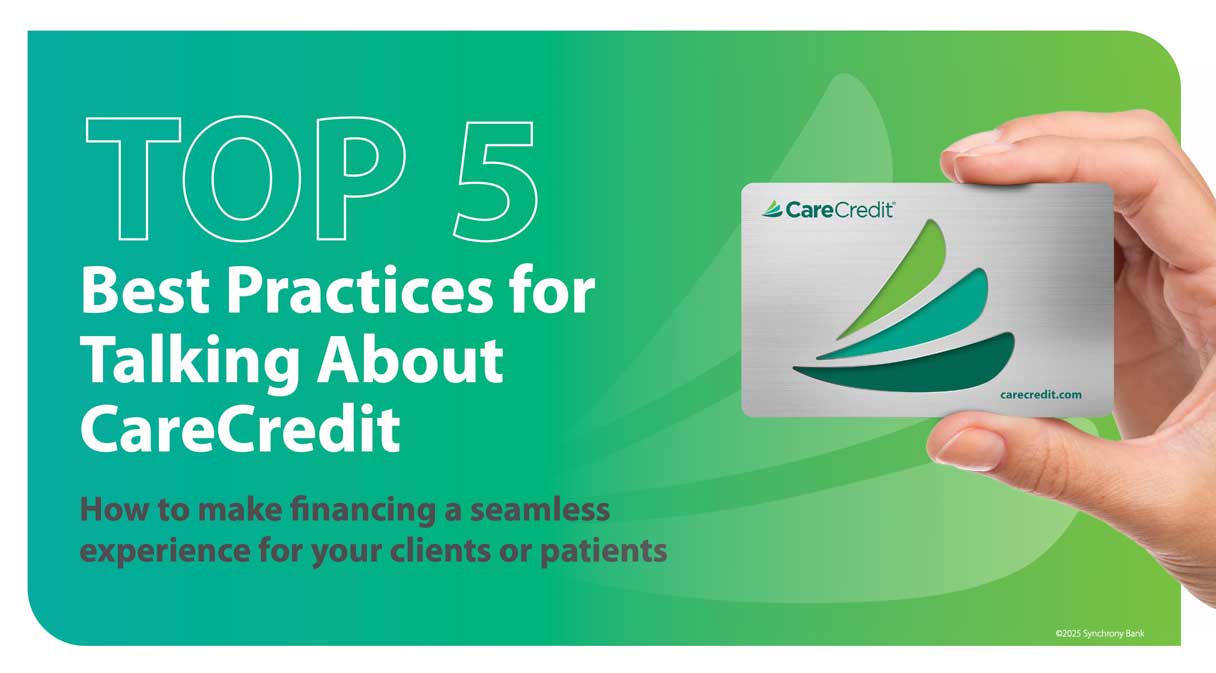Maximizing Advances in Hearing and Vision Technology
High-tech, high-value hearing and vision products can offer a state-of-the-art solution for patients and a business opportunity for your practice.
By Robyn Tellefsen
Digital Writer
Posted Nov 14, 2025 - 7 min read

Eyeglasses that double as hearing aids. Contact lenses that deliver medication to the eye. Hearing devices that stream movie theater audio directly to the ear.
Such innovations are changing the landscape of hearing and vision care, offering streamlined solutions that meet today’s patient wants and needs. As a provider, embracing advancements in these industries — along with offering financing options that help bring premium products within patients’ reach — can empower you to support patient health and practice growth at the same time.
Explore how integrating complementary hearing and vision services, along with introducing the latest innovations, can enhance your service offerings and help you drive practice growth.
The Value of Combined Hearing and Vision Screenings
Rather than assessing sensory systems in isolation, combined hearing and vision screenings can contribute to overall wellness. After all, integrated screening programs can facilitate early detection and intervention for both hearing and vision impairments, which may improve patient outcomes and quality of life. Combining these sensory screenings makes sense, as the age groups most affected by hearing problems are often the same as those most impacted by vision problems — older adults and school-age children.1
Of course, sensory impairment affects other age groups as well. According to Synchrony’s Hearing Health and Loss Prevention Study, 40% of young adults under 30 have some level of hearing loss.2 The good news is that many young people are addressing the issue. According to MarkeTrak 2025, a survey commissioned by the Hearing Industries Association, adults under 34 have the highest adoption rates for over-the-counter (OTC) hearing aids.3 This increased demand for hearing aids at younger ages underscores the importance of early screenings and intervention. By integrating hearing and vision care into checkups, providers can help support long-term patient health.
A shift toward total health
This integration is consistent with the paradigm shift toward total health, where providers are encouraged to focus more on what matters to patients than what is the matter with them. That entails getting to know each patient as a person, then working with them to develop a personalized health plan based on their needs, values and goals.
Consider the fact that consumers demand connectivity, including connected hearing devices. According to MarkeTrak 2025, 70% of hearing aid owners surveyed have hearing aids with some type of wireless capability, up from 42% in 2015.3
By discovering what’s important to your patients, you can help provide the care and products that match their needs and preferences. Take a look at some of the latest advancements in hearing and vision technology to highlight in your business or practice.
Advanced Vision Technology
The future of optometry and ophthalmology includes advanced eye care technology such as drug-eluting contact lenses and smart contact lenses. By staying up to date on the latest innovations in vision care, providers are uniquely positioned to educate patients on fitting and monitoring these types of groundbreaking devices to help ensure ocular health and safety.4
High-tech contact lenses
Contact lenses that deliver medication like antibiotics, NSAIDs and steroids to the eye are currently being tested to allow for controlled and effective drug delivery. Such advancements may enable better monitoring and treatment of patients, leading to improved outcomes.4
Another up-and-coming vision technology? Smart contact lenses, which use motion-tracking technology to provide the wearer with a type of augmented reality, allowing them to access a micro-LED display with merely a glance. These recreational lenses can launch applications like navigation, flight information, fitness tracking, calendars and even visual field expanders or contrast enhancers. With the advent of smart tools like these, optometrists and ophthalmologists have a distinct opportunity to expand patient care and support practice growth.4
Prescription smart glasses
Prescription smart glasses integrate augmented reality, cameras, voice assistants and other advanced features into corrective lenses. By consolidating multiple functions into a single pair of eyewear, smart glasses can help users streamline their daily routines. Providers that offer smart eyewear in their business or practice can help provide patients with the real-time connectivity they seek.
A novel entry in the smart eyewear space: eyeglasses inspired by the eyes of a fly and powered by augmented and virtual reality technology. The goal? Vision restoration for macular degeneration. These SolidddVision™ glasses have earned positive feedback from clinical trial participants, making this up-and-coming technology one to watch.5
Product highlight: Ray-Ban® Meta AI glasses
For patients seeking prescription eyewear that blends fashion with technology, Ray-Ban Meta AI glasses offer a comprehensive solution. Users can capture photos and videos, listen to music, make calls, send texts and even live stream their daily adventures — directly through their stylish smart glasses. By showcasing such innovative products, eye care providers can address patients’ vision care and lifestyle preferences simultaneously.
Hearing Aid Advancements
Hearing technology is growing in leaps and bounds, from earbuds with hearing enhancement features to hearing aids with Auracast™ technology.3 Such advancements present an opportunity for audiologists and other hearing care providers to embrace innovations that can benefit both patient health and practice growth. Consider this cutting-edge technology:
AI features
Artificial intelligence (AI) has revolutionized hearing devices, bringing an array of capabilities to the technology that helps people hear.6 And since AI-enabled hearing aids learn from patients’ listening habits, the more patients use them, the better the devices can understand and adapt to their preferred settings. Hearing care providers can leverage this functionality to emphasize the importance of consistent hearing device use.
Providers can also highlight AI hearing device features that fit patients’ needs and preferences. For example, some older adults may be interested in features such as fall detection and cognitive tracking, while others may be enthusiastic about hearing devices with fitness tracking capabilities. By educating patients on the latest technology in hearing devices, your practice can extend services beyond basic hearing support in favor of hearing solutions that fit their lifestyle.
Wireless streaming
According to MarkeTrak 2025, more than half of those surveyed who purchased hearing aids in the last five years can stream directly from their smartphone — and satisfaction is higher for those who regularly use their smartphone and hearing aid together than overall hearing aid satisfaction alone.3 By encouraging patients to access the advanced technology in modern hearing devices, providers can help improve the patient experience.
Consider this: With Bluetooth® technology, patients can stream calls, music, videos, podcasts and more from their smartphone directly to their hearing aids. And with the latest Bluetooth Low Energy Audio, patients can pair their hearing aids with their smartphone using less power than traditional wireless streaming — enabling them to stay connected without rapidly draining their hearing device battery.7
Shared audio experiences
The latest wave in hearing aid advancements is Auracast technology, which enables sound transmission to an unlimited number of audio devices simultaneously. That means users can tune in to public audio streams in places like airports, gyms, theaters and waiting rooms all through Auracast-equipped hearing devices. As more manufacturers adopt this next-generation technology, people with hearing loss can benefit from shared audio experiences and improved hearing in public places.8
Product highlight: Nuance Audio Glasses
At the intersection of optometry and audiology, Nuance Audio Glasses embed prescription eyewear with an air conduction hearing device for adults with perceived mild to moderate hearing loss. Stylish frames give the appearance of traditional eyeglasses while providing discreet open-ear hearing technology — offering vision and hearing benefits in one seamless solution.
While a prescription is not required to purchase these over-the-counter hearing aid glasses, hearing care providers are still in a position to provide professional assistance. According to MarkeTrak 2025, many OTC hearing aid users get an evaluation from a hearing care professional before making a purchasing decision, and hearing aid owners who received assistance from a hearing care professional report higher satisfaction than those who did not.3
Financing Options for Premium Products
While patients may be excited about supporting their hearing and vision health with the latest technology, costs could keep them from committing to optimal devices.
According to Synchrony’s Healthcare Journey Research Consumers and Providers report, 56% of ophthalmology patients surveyed said they struggle to pay out-of-pocket costs.9 In addition, half of hearing aid consumers surveyed wish they had worn hearing aids earlier, and 68% said cost was the reason they didn’t.10
That’s why it’s important to inform patients about options that can help them pay for the products they want and need. Case in point: 58% of consumers who have hearing loss but do not use a hearing device like the idea of being able to finance the cost of one.2 And 43% of consumers say they would be more likely to get vision care if they could pay for it over time.11
With financing options like the CareCredit credit card, for example, patients can pay for their hearing and vision products over time.* It’s easy to use CareCredit’s Payment Calculator to show patients how the cost of their premium glasses, contact lenses or hearing devices could be broken into monthly payments to help fit their budget.
By offering flexible patient financing, your business or practice can help patients prioritize hearing and vision care recommendations and purchase the high-tech products they may seek.
Leveraging High-Tech Solutions
From AI hearing devices to smart glasses — or innovations yet to come — premium products present a state-of-the-art solution for patients and a business opportunity for your practice. By taking a forward-thinking, lifestyle-oriented approach to treatment and care, hearing and vision care providers can offer solutions that help address the needs and desires of modern patients.
A Patient Financing Solution for Hearing and Vision Practices
If you are looking for a way to connect your patients with flexible financing that empowers them to pay for the care they want and need, consider offering the CareCredit credit card as a financing solution. CareCredit allows cardholders to pay for out-of-pocket health and wellness expenses over time while helping enhance the payments process for your practice or business.
When you accept CareCredit, patients can see if they prequalify with no impact to their credit score, and those who apply, if approved, can take advantage of special financing on qualifying purchases.* Additionally, your practice or business will be paid directly within two business days.
Learn more about the CareCredit credit card as a patient financing solution or start the provider enrollment process by filling out this form.
Author Bio
Robyn Tellefsen is a freelance writer and editor with more than 20 years of experience covering health and wellness, finance and more. Her work has appeared on sites such as LoopNet, Beachside Rehab, First Horizon Bank, SoFi, A Place for Mom, American Express, Chase and more.
Healthcare payment and financing solution
The CareCredit health and wellness credit card helps improve the payment experience for patients and clients, and your financial performance.
Get StartedReady to help more patients and clients get the care they want and need?
Get StartedReady to help more patients and clients get the care they want and need?
Get Started*Subject to credit approval.
The information, opinions and recommendations expressed in the article are for informational purposes only. Information has been obtained from sources generally believed to be reliable. However, because of the possibility of human or mechanical error by our sources, or any other, Synchrony and any of its affiliates, including CareCredit, (collectively, “Synchrony”) does not provide any warranty as to the accuracy, adequacy or completeness of any information for its intended purpose or any results obtained from the use of such information. The data presented in the article was current as of the time of writing. Please consult with your individual advisors with respect to any information presented.
All product, service and company names are the trademarks of their original owners. The use of any trade name or trademark is for identification and reference only and does not imply any endorsement, sponsorship or affiliation by or with the trademark holder of their brand.
© 2025 Synchrony Bank.
Sources:
1 Oosthuizen, Ilze et al. “Combined hearing and vision screening programs: A scoping review,” Frontiers in Public Health. March 13, 2023. Retrieved from: https://www.frontiersin.org/journals/public-health/articles/10.3389/fpubh.2023.1119851/full
2 Hearing Health and Loss Prevention Study, Synchrony. February 2024. (CareCredit is a Synchrony solution.)
3 Dobyan, Bridget. “20Q: Interpreting the hearing health landscape through MarkeTrak — from insight to impact,” AudiologyOnline. August 11, 2025. Retrieved from: https://www.audiologyonline.com/articles/20q-interpreting-hearing-health-landscape-29350 MarkeTrak 2025 (MT2025) conducted by Az Marketing Research, Inc.
4 “New technologies shaping optometry’s future,” American Optometric Association. August 20, 2024. Retrieved from: https://www.aoa.org/news/practice-management/perfect-your-practice/new-technologies-shaping-optometrys-future
5 Mocerino, Maria. “New smartglasses use insect vision tech to restore full 3D visual experience,” Interesting Engineering. January 25, 2025. Retrieved from: https://interestingengineering.com/innovation/vr-solidddvision-smartglasses-inspired-by-fly
6 “Hearing aids: State of the art technology,” Hearing Industries Association. Accessed October 23, 2025. Retrieved from: https://www.betterhearing.org/hearing-aids/state-of-the-art-technology/
7 “The latest advancements in hearing aid technology in 2025,” U.S. Hearing Solutions. March 14, 2025. Retrieved from: https://www.ushearingsolutions.com/blog/hearing-aid-technology-2025/
8 Frazier, Stephen O. “Auracast is expanding audio sharing — for everyone,” Hearing Health Foundation. September 3, 2024. Retrieved from: https://hearinghealthfoundation.org/blogs/auracast-is-expanding-audio-sharing-for-everyone
9 Healthcare Journey Research Consumers and Providers report, Synchrony, 2023. (CareCredit is a Synchrony solution.)
10 CareCredit Hearing Research, 2023. (CareCredit is a Synchrony solution.)
11 Vision Care Industry Study, Synchrony. August 2025. (CareCredit is a Synchrony solution.)




